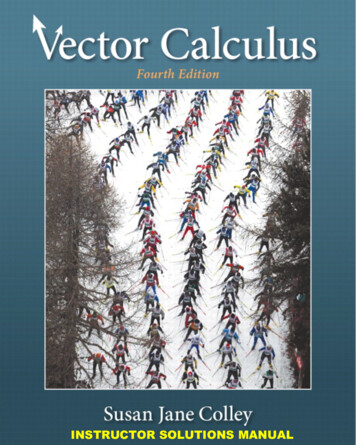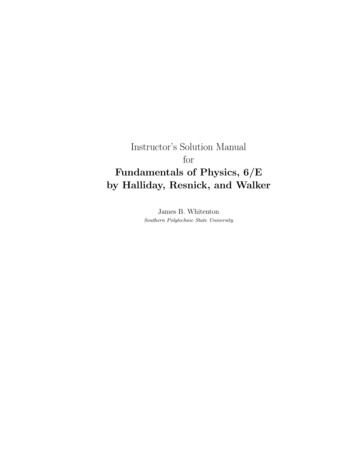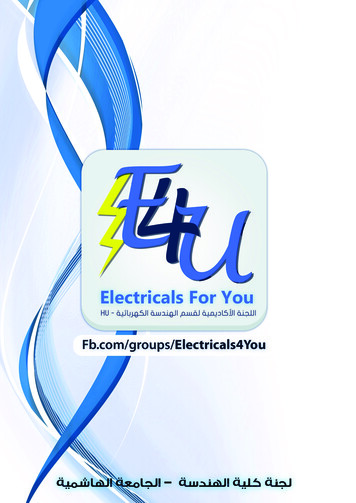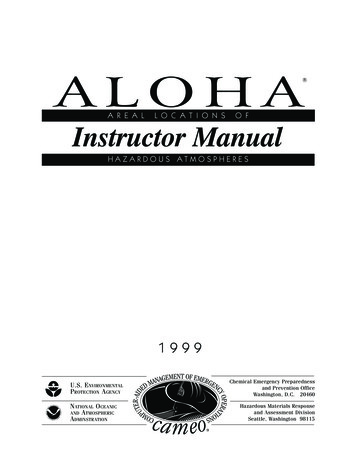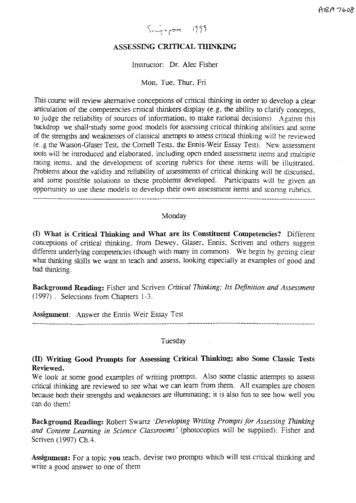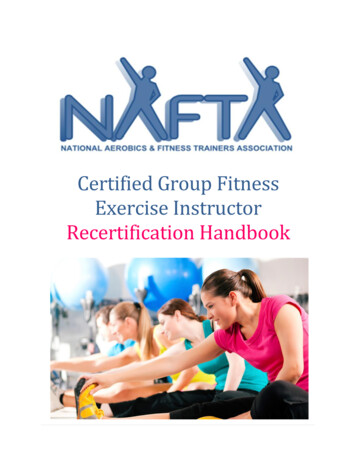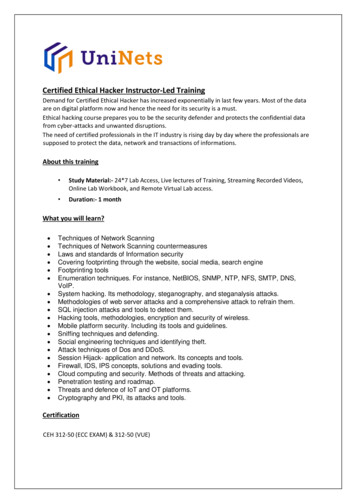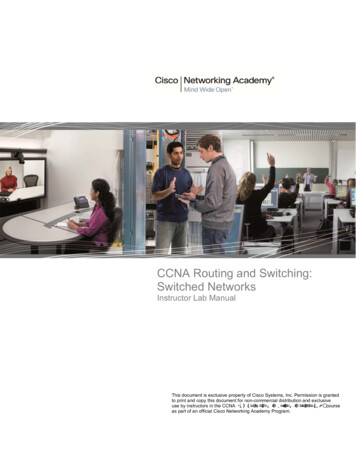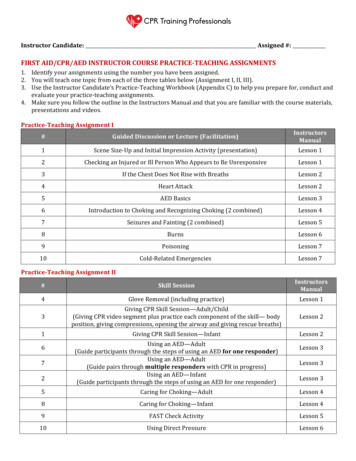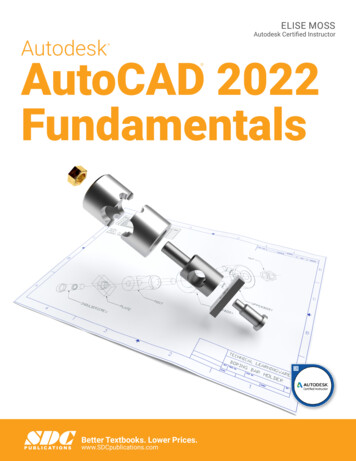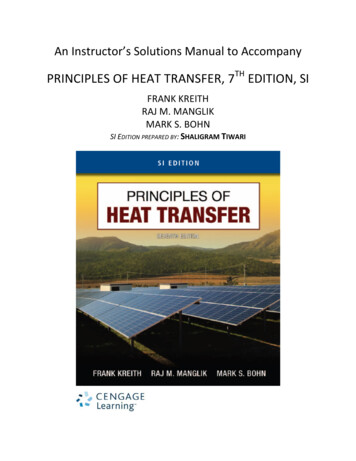
Transcription
An Instructor’s Solutions Manual to AccompanyPRINCIPLES OF HEAT TRANSFER, 7TH EDITION, SIFRANK KREITHRAJ M. MANGLIKMARK S. BOHNSI EDITION PREPARED BY: SHALIGRAM TIWARI
ISBN-13: 978-1-4390-6187-9ISBN-10: 1-4390-6187-4 2011 Cengage LearningALL RIGHTS RESERVED. No part of this work covered by thecopyright herein may be reproduced, transmitted, stored, orused in any form or by any means graphic, electronic, ormechanical, including but not limited to photocopying,recording, scanning, digitizing, taping, Web distribution,information networks, or information storage and retrievalsystems, except as permitted under Section 107 or 108 of the1976 United States Copyright Act, without the prior writtenpermission of the publisher except as may be permitted by thelicense terms below.For product information and technology assistance, contact us atCengage Learning Academic Resource Center,1-800-423-0563.For permission to use material from this text or product, submitall requests online at www.cengage.com/permissions.Further permissions questions can be emailed topermissionrequest@cengage.com.Cengage Learning200 First Stamford Place, Suite 400Stamford, CT 06902USACengage Learning is a leading provider of customizedlearning solutions with office locations around the globe,including Singapore, the United Kingdom, Australia,Mexico, Brazil, and Japan. Locate your local office at:international.cengage.com/region.Cengage Learning products are represented inCanada by Nelson Education, Ltd.For your course and learning solutions, visitwww.cengage.com/engineering.Purchase any of our products at your local collegestore or at our preferred online storewww.cengagebrain.com.NOTE: UNDER NO CIRCUMSTANCES MAY THIS MATERIAL OR ANY PORTION THEREOF BE SOLD, LICENSED, AUCTIONED,OR OTHERWISE REDISTRIBUTED EXCEPT AS MAY BE PERMITTED BY THE LICENSE TERMS HEREIN.READ IMPORTANT LICENSE INFORMATIONDear Professor or Other Supplement Recipient:Cengage Learning has provided you with this product (the“Supplement”) for your review and, to the extent that you adoptthe associated textbook for use in connection with your course(the “Course”), you and your students who purchase thetextbook may use the Supplement as described below.Cengage Learning has established these use limitations inresponse to concerns raised by authors, professors, and otherusers regarding the pedagogical problems stemming fromunlimited distribution of Supplements.Cengage Learning hereby grants you a nontransferable licenseto use the Supplement in connection with the Course, subject tothe following conditions. The Supplement is for your personal,noncommercial use only and may not be reproduced, postedelectronically or distributed, except that portions of theSupplement may be provided to your students IN PRINT FORMONLY in connection with your instruction of the Course, so longas such students are advised that they may not copy ordistribute any portion of the Supplement to any third party. Testbanks and other testing materials may be made available in theclassroom and collected at the end of each class session, orPrinted in the United States of America1 2 3 4 5 6 7 15 14 13 12 11posted electronically as described herein. Any material postedelectronically must be through a password-protected site, with allcopy and download functionality disabled, and accessible solely byyour students who have purchased the associated textbook for theCourse. You may not sell, license, auction, or otherwise redistributethe Supplement in any form. We ask that you take reasonablesteps to protect the Supplement from unauthorized use,reproduction, or distribution. Your use of the Supplement indicatesyour acceptance of the conditions set forth in this Agreement. If youdo not accept these conditions, you must return the Supplementunused within 30 days of receipt.All rights (including without limitation, copyrights, patents, and tradesecrets) in the Supplement are and will remain the sole andexclusive property of Cengage Learning and/or its licensors. TheSupplement is furnished by Cengage Learning on an “as is” basiswithout any warranties, express or implied. This Agreement will begoverned by and construed pursuant to the laws of the State ofNew York, without regard to such State’s conflict of law rules.Thank you for your assistance in helping to safeguard the integrityof the content contained in this Supplement. We trust you find theSupplement a useful teaching tool.
INSTRUCTOR'S SOLUTIONS MANUAL TOACCOMPANYPRINCIPLES OFHEAT TRANSFERSEVENTH EDITION, SIFRANK KREITHRAJ M. MANGLIKMARK S. BOHNSI EDITION PREPARED BY:SHALIGRAM TIWARIIndian Institute of Technology Madras
TABLE OF CONTENTSCHAPTERPAGE1 . 12 . 853 . 2314 . 3115 . 4216 . 5137 . 6078 . 6839 . 78110 . 871
67706 00 FM pi-xxiii.qxd5/14/109:32 AMPage ixCONTENTSChapter 1 Basic Modes of Heat Transfer1.11.21.31.41.51.61.71.8The Relation of Heat Transfer to Thermodynamics 3Dimensions and Units 7Heat Conduction 9Convection 17Radiation 21Combined Heat Transfer Systems 23Thermal Insulation 45Heat Transfer and the Law of Energy Conservation 51References 58Problems 58Design Problems 68Chapter 2 Heat n 71The Conduction Equation 71Steady Heat Conduction in Simple Geometries 78Extended Surfaces 95Multidimensional Steady Conduction 105Unsteady or Transient Heat Conduction 116Charts for Transient Heat Conduction 134Closing Remarks 150References 150Problems 151Design Problems 163Chapter 3 Numerical Analysis of Heat Conduction3.13.23.3166Introduction 167One-Dimensional Steady Conduction 168One-Dimensional Unsteady Conduction 180ixCopyright 2011 Cengage Learning, Inc. All Rights Reserved. May not be copied, scanned, or duplicated, in whole or in part.
67706 00 FM pi-xxiii.qxdx5/14/109:32 AMPage xContents3.4*3.5*3.6*3.7Two-Dimensional Steady and Unsteady Conduction 195Cylindrical Coordinates 215Irregular Boundaries 217Closing Remarks 221References 221Problems 222Design Problems 228Chapter 4 Analysis of Convection Heat 4.13*4.14Introduction 231Convection Heat Transfer 231Boundary Layer Fundamentals 233Conservation Equations of Mass, Momentum, and Energy for Laminar Flow Overa Flat Plate 235Dimensionless Boundary Layer Equations and SimilarityParameters 239Evaluation of Convection Heat Transfer Coefficients 243Dimensional Analysis 245Analytic Solution for Laminar Boundary Layer Flow Over a Flat Plate 252Approximate Integral Boundary Layer Analysis 261Analogy Between Momentum and Heat Transfer in Turbulent Flow Overa Flat Surface 267Reynolds Analogy for Turbulent Flow Over Plane Surfaces 273Mixed Boundary Layer 274Special Boundary Conditions and High-Speed Flow 277Closing Remarks 282References 283Problems 284Design Problems 294Chapter 5 Natural Convection5.15.25.35.4*5.55.6*230296Introduction 297Similarity Parameters for Natural Convection 299Empirical Correlation for Various Shapes 308Rotating Cylinders, Disks, and Spheres 322Combined Forced and Natural Convection 325Finned Surfaces 328Copyright 2011 Cengage Learning, Inc. All Rights Reserved. May not be copied, scanned, or duplicated, in whole or in part.
67706 00 FM pi-xxiii.qxd5/14/109:32 AMPage xiContents5.7Closing Remarks 333References 338Problems 340Design Problems 348Chapter 6 Forced Convection Inside Tubes and Ducts6.16.2*6.36.4*6.56.66.7Introduction 351Analysis of Laminar Forced Convection in a Long Tube 360Correlations for Laminar Forced Convection 370Analogy Between Heat and Momentum Transfer in Turbulent Flow 382Empirical Correlations for Turbulent Forced Convection 386Heat Transfer Enhancement and Electronic-Device Cooling 395Closing Remarks 406References 408Problems 411Design Problems 418Chapter 7 Forced Convection Over Exterior Surfaces7.17.27.3*7.47.5*7.6*7.7420Flow Over Bluff Bodies 421Cylinders, Spheres, and Other Bluff Shapes 422Packed Beds 440Tube Bundles in Cross-Flow 444Finned Tube Bundles in Cross-Flow 458Free Jets 461Closing Remarks 471References 473Problems 475Design Problems 482Chapter 8 Heat n 485Basic Types of Heat Exchangers 485Overall Heat Transfer Coefficient 494Log Mean Temperature Difference 498Heat Exchanger Effectiveness 506Heat Transfer Enhancement 516Microscale Heat Exchangers 524Copyright 2011 Cengage Learning, Inc. All Rights Reserved. May not be copied, scanned, or duplicated, in whole or in part.xi
67706 00 FM pi-xxiii.qxdxii5/14/109:32 AMPage xiiContents8.8Closing Remarks 525References 527Problems 529Design Problems 539Chapter 9 Heat Transfer by al Radiation 541Blackbody Radiation 543Radiation Properties 555The Radiation Shape Factor 571Enclosures with Black Surfaces 581Enclosures with Gray Surfaces 585Matrix Inversion 591Radiation Properties of Gases and Vapors 602Radiation Combined with Convection and Conduction 610Closing Remarks 614References 615Problems 616Design Problems 623Chapter 10 Heat Transfer with Phase on to Boiling 625Pool Boiling 625Boiling in Forced Convection 647Condensation 660Condenser Design 670Heat Pipes 672Freezing and Melting 683References 688Problems 691Design Problems 696Appendix 1 The International System of UnitsAppendix 2 Data TablesA3A6Properties of Solids A7Thermodynamic Properties of Liquids A14Heat Transfer Fluids A23Copyright 2011 Cengage Learning, Inc. All Rights Reserved. May not be copied, scanned, or duplicated, in whole or in part.
Chapter 1PROBLEM 1.1The outer surface of a 0.2m-thick concrete wall is kept at a temperature of –5 C, while theinner surface is kept at 20 C. The thermal conductivity of the concrete is 1.2 W/(m K).Determine the heat loss through a wall 10 m long and 3 m high.GIVEN10 m long, 3 m high, and 0.2 m thick concrete wallThermal conductivity of the concrete (k) 1.2 W/(m K)Temperature of the inner surface (Ti) 20 CTemperature of the outer surface (To) –5 CFINDThe heat loss through the wall (qk)ASSUMPTIONSOne dimensional heat flowThe system has reached steady stateSKETCHL 0.2 mL 10mH 3mqkTi 20 CTo – 5 CSOLUTIONThe rate of heat loss through the wall is given by Equation (1.2)qk AK(ΔT)Lqk (10 m) (3m) (1.2 W/(m K) )(20 C – (–5 C))0.2 mqk 4500 WCOMMENTSSince the inside surface temperature is higher than the outside temperature heat is transferred from theinside of the wall to the outside of the wall.1 2011 Cengage Learning. All Rights Reserved. May not be scanned, copied or duplicated, or posted to a publicly accessible website, in whole or in part.
PROBLEM 1.2The weight of the insulation in a spacecraft may be more important than the spacerequired. Show analytically that the lightest insulation for a plane wall with a specifiedthermal resistance is that insulation which has the smallest product of density timesthermal conductivity.GIVENInsulating a plane wall, the weight of insulation is most significantFINDShow that lightest insulation for a given thermal resistance is that insulation which has the smallestproduct of density (ρ) times thermal conductivity (k)ASSUMPTIONSOne dimensional heat transfer through the wallSteady state conditionsSOLUTIONThe resistance of the wall (Rk), from Equation (1.13) isRk LAkwhereL the thickness of the wallA the area of the wallThe weight of the wall (w) isw ρALSolving this for LL wρASubstituting this expression for L into the equation for the resistanceRk wρ k A2 w ρ k Rk A2Therefore, when the product of ρ k for a given resistance is smallest, the weight is also smallest.COMMENTSSince ρ and k are physical properties of the insulation material they cannot be varied individually.Hence in this type of design different materials must be tried to minimize the weight.PROBLEM 1.3A furnace wall is to be constructed of brick having standard dimensions 22.5 cm 11 cm 7.5 cm. Two kinds of material are available. One has a maximum usable temperatureof 1040 C and a thermal conductivity of 1.7 W/(m K), and the other has a maximumtemperature limit of 870 C and a thermal conductivity of 0.85 W/(m K). The bricks costthe same and can be laid in any manner, but we wish to design the most economical wallfor a furnace with a temperature on the hot side of 1040 C and on the cold side of200 C. If the maximum amount of heat transfer permissible is 950 W/m2 for each squarefoot of area, determine the most economical arrangements for the available bricks.2 2011 Cengage Learning. All Rights Reserved. May not be scanned, copied or duplicated, or posted to a publicly accessible website, in whole or in part.
GIVENFurnace wall made of 22.5 cm 11 cm 7.5 cm bricks of two typesType 1 bricks Maximum useful temperature (T1, max) 1040 C Thermal conductivity (k1) 1.7 W/(m K)Type 2 bricks Maximum useful temperature (T2, max) 870 C Thermal conductivity (k2) 0.85 W/(m K)Bricks cost the sameWall ho
The heat loss through the wall (qk) ASSUMPTIONS One dimensional heat flow The system has reached steady state SKETCH L 0.2 m Ti 20 C To – 5 C q k L 0m H 3m SOLUTION The rate of heat loss through the wall is given by Equation (1.2) qk AK L (ΔT) qk (10m)(3m) 1.2 W/(m K)() 0.2m (20 C – (–5 C)) qk 4500 W COMMENTS
